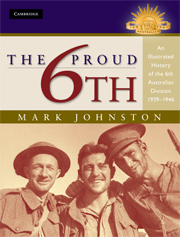Book contents
- Frontmatter
- Epigraph
- Contents
- List of Maps
- Acknowledgements
- Conventions and Abbreviations
- Introduction
- 1 Origins and Early Days
- 2 Bardia
- 3 Tobruk to Benghazi
- 4 Greece
- 5 Crete
- 6 Syria
- 7 Return to Australia
- 8 Kokoda to the Sea
- 9 Wau-Salamaua
- 10 The Longest Wait: Australia 1943–4
- 11 Aitape–Wewak
- 12 Conclusion
- Appendix 1 6th Division Casualties
- Appendix 2 6th Division Honours and Awards
- Notes
- Bibliography
- Index
Introduction
Published online by Cambridge University Press: 05 February 2015
- Frontmatter
- Epigraph
- Contents
- List of Maps
- Acknowledgements
- Conventions and Abbreviations
- Introduction
- 1 Origins and Early Days
- 2 Bardia
- 3 Tobruk to Benghazi
- 4 Greece
- 5 Crete
- 6 Syria
- 7 Return to Australia
- 8 Kokoda to the Sea
- 9 Wau-Salamaua
- 10 The Longest Wait: Australia 1943–4
- 11 Aitape–Wewak
- 12 Conclusion
- Appendix 1 6th Division Casualties
- Appendix 2 6th Division Honours and Awards
- Notes
- Bibliography
- Index
Summary
‘Good old 6th Divvy.’ Thus wrote a 9th Division private in his diary in Palestine on hearing news of the first Australian land battle of the war, at Bardia in Libya. That battle, in January 1941, was a great victory for the 6th Division and set the tone for the Second AIF's entire war. In short, the 6th's role was pivotal in Australian military history, for its men fulfilled the awesome responsibility of proving that a new generation of Australians could emulate the high achievements of the First AIF. Not surprisingly, then, the 6th Division was a formation that was a household name in Australia throughout World War II.
Yet today the 6th Division is arguably the least known of the four infantry divisions of the Second AIF: 6th, 7th, 8th and 9th. In wartime its members claimed primacy, for theirs was not only the first to fight, but also the first division formed – in 1939, no less. It was a badge of great pride to be a ‘Thirty-Niner’, and it was a badge often waved in front of men of the later divisions: a 9th Division veteran recalled for me his discomfort when the warmth he showed the first 6th Division men he saw in Libya was met with disdain and accusations of being too slow to join up. Reinforcements to the 6th Division itself often met much the same attitude, at least in the Middle East. Men who joined in 1940 and saw every campaign of the division still smart in the 21st century at the recollection of their treatment at the hands of the originals. Though irksome to outsiders, this pride and sense of superiority helped to ensure that the 6th Division's men continued to fight superbly and risk their lives even when the war was all but won.
- Type
- Chapter
- Information
- The Proud 6thAn Illustrated History of the 6th Australian Division 1939–1946, pp. 1 - 6Publisher: Cambridge University PressPrint publication year: 2008

